Nematodes are round worms, named as such because they are round in cross section. There are a great many species that are medically or economically important as they can cause diseases of plants, animals and man. There are also a great many more invisible to the naked eye that are involved in the break down and decomposition of dead material.
Nematoda - Nematodes - Round Worms
Nematodes are probably the commonest multicellular organism that you've never heard of and have hardly ever seen. They occur in all environments, in fresh and sea water, on land, in polar regions and in deserts. They can be found in hot springs, high up mountains and in the deepest oceans. They have been around for around a billion years and so are one of the most ancient and diverse of animal groups on earth.
Typical Nematodes

A soybean cyst nematode and egg
False colour picture taken with a scanning
electron microscope of a plant parasitic nematode.
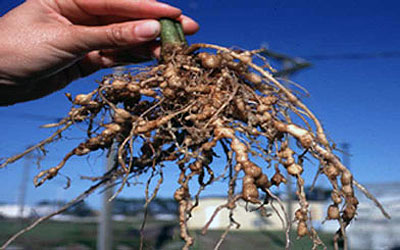
Galls (swollen regions) formed on vegetable
roots
A result of infestation by parasitic
nematodes.
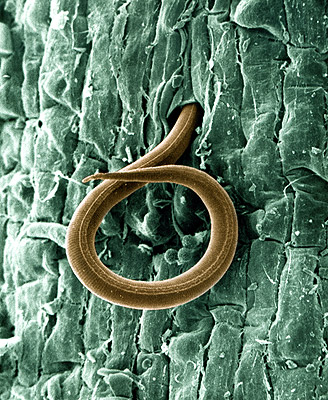
Meloidogyne incognita-
a plant parasite
Magnified 500x, in the
process of penetrating a tomato root. The worm will
establish a feeding site once inside, which causes a
nutrient-robbing gall where the worms will reproduce.
Picture- William Wergin and
Richard Sayre. Colorized by Stephen Ausmus. U.S. Department
of Agriculture, Creative Commons Attribution 2.0 Generic
license.
Other Nematodes
I can't quite bring myself to call them "cool" like
I have on other pages in this section as many are just
too gross.
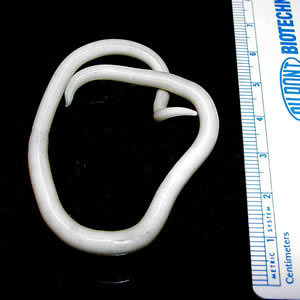
Ascaris lumbricoides
Typically 15
to 35cm in length, these are an intestinal parasite
of humans
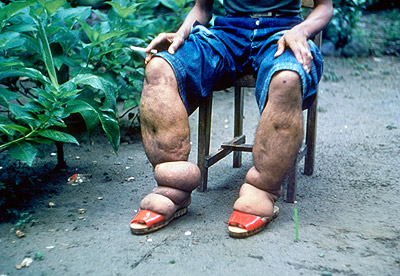
Elephantiasis, a result of a
parasitic infection of filarial nematodes.
The nematodes that cause this are microscopic and cause
a blockage of the lymphatic system and so fluid retention
with tissue and skin thickening. The legs and genitals
are particularly affected, the scrotum can swell to
the size of a basketball in some unfortunate individuals.
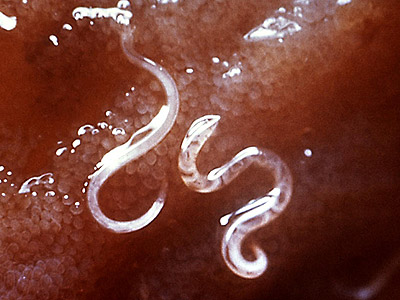
Ancylostoma caninum -
a hookworm
attached to the intestine of
a dog, though species of hookworm infect other mammals
including humans. The name comes from them being bent
over at the head end so forming a hook.
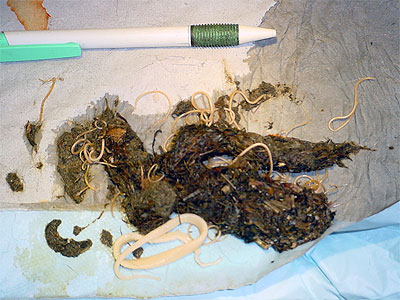
Nematode infestation in the vomit
of a cat
(yes I know it's gruesome, but
nematodes are like that)
picture - Kalumet at de.wikipedia,
published under GNU Free Documentation License, Version
1.2
Kingdom - Animalia
Phylum - Nematodes
Basic Features:
- Roundworms get their name from their round cross section.
- Long thread-like bodies.
- Usually very small to microscopic, some parasitic members however may be a metre long.
- Simple tube-like gut with a mouth and anus.
- No circulatory system, gas exchange and excretion are by diffusion across the body wall.
- There is very little superficial difference between nematode species, they all look pretty much like larger or smaller, somewhat fatter or skinnier versions of each other.
- Sexual reproduction, sexes separate, no asexual reproduction. Males are usually smaller than the females, the females of some species can deposit over 100,000 eggs per day.
What do nematodes eat?
Many free-living nematodes are carnivorous, they feed on animals that are even smaller than they are including other nematodes.
Other free living nematodes feed on phytoplankton such as diatoms, algae and fungi. Many terrestrial species feed on plant roots, penetrating the cells and sucking out the contents. They are considered parasitic in the way that fleas are parasitic on other animals, they can cause great damage to the plants in this manner and can spread viral and other diseases.
Species that live in sediments and other aquatic environments ingest particles of the substrate and then digest associated bacteria and / or organic material.
Others feed more directly on dead organic material such as decomposing plants and animals or dung where again they may actually be eating the bacteria or fungi that are feeding on the decomposing material rather than being a decomposer directly.
The parasitic forms of nematodes show a great many variations on the theme.
- Ectoparasite of plants - lives outside the plant
- Endoparasite of plants - lives and breeds inside the plant having entered as a juvenile
- Saprophagous - juveniles and adults are free living, juveniles enter invertebrate animal host and cause no harm, but feed on dead tissues when the host dies.
- Zooparasitic juvenile stages only - juveniles parasitize a host organism and then leave when it becomes adult, the adult does not feed and may not have a functioning gut. its job is reproduction only.
- Phytoparasitic juvenile, Zooparasitic adult - juvenile lives as a plant parasite and is taken in by the animal host when it feeds. The worm then grows to be an adult parasite inside the animal and produces juvenile worms within the host, these are then ready to enter and parasitize a plant host again after passing out of the animal host.
- Zooparasitic adult females only - young live in the soil, males die after fertilizing females in the soil, pregnant females then enter the animal host.
- ... and a whole range of other strategies with more than one host to help the worms distribute themselves and complete their life cycles
What eats nematodes?
Free living nematodes are themselves prey for almost any predator that is larger than they are. This will include other nematodes including those of the same species.
There is a surprising "predator" of soil dwelling nematodes however and that is a fungus. This fungus lays traps of rings attached to the fungal hyphae (thread-like growths). Each ring is made of three highly specialized cells that swell up rapidly when a nematode worm passes through them. The worm is captured and the fungus passes hyphae into it to digest it.
The group includes:
Most nematodes live in the "benthos" - sediments, whether soil or aquatic sediments. A square metre of mud from an inshore area near the coast of Holland was measured to contain over 4 million nematodes. Good farm soil as well as containing a large number of earthworms can also contain from several hundred million to several billion nematodes per acre.
A single decomposing apple on an orchard floor has had 90,000 nematodes counted in it of several species and a single decomposing fig around 50,000 of at least eight species.
Although there are so many free-living nematodes, they tend to be microscopic and therefore unknown to all but the scientists who study them. There are however a large number of nematodes that are parasitic on a wide range of animals and plants, these are rather better known than the free-living forms. These parasitic forms have major economic and health influences in parts of the world where they are found.
- Vinegar eels - tiny free living worms that can live in vinegar or liquids that can become vinegary such as cider, wine, beer etc.
- Caenorhabditis elegans - a 1mm long free living nematode that has been used for many years (starting 1974) as a "model organism" for scientific research. At maturity all individuals have exactly 959 cells. It was the first multicellular organism to have its complete genome sequenced (in 1998), leading ultimately to the "Human Genome Project."
- Toxocara canis - the one that puppies are "wormed" to remove and that can cause blindness in children if they come into contact with animal faeces and are infected.
- Hookworms
- Pinworms
- Whipworms
- Loa loa - the Africa eye worm
- Guinea worm
- Species that produce "filiariasis" in man - Elephantiasis
The life cycle of the human parasitic
nematode Loa loa worm
known as "African eye worm", Loiasis
or Loa loa filariasis

Round worms in a cats intestine - not for the
squeamish
A large nematode feeding on a smaller one (this
is a bit gruesome too).
Top banner picture, Caenorhabditis elegans an approx 1mm long nematode coloured by a stain that affects only oils - courtesy of Tormikotkas - used under Creative Commons Attribution-Share Alike 3.0 Unported license.
